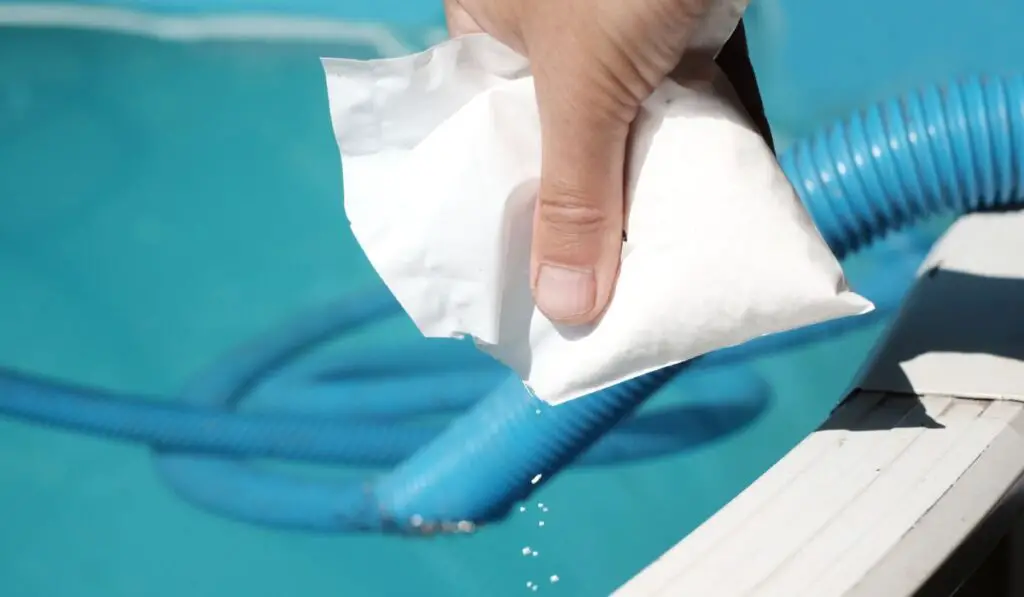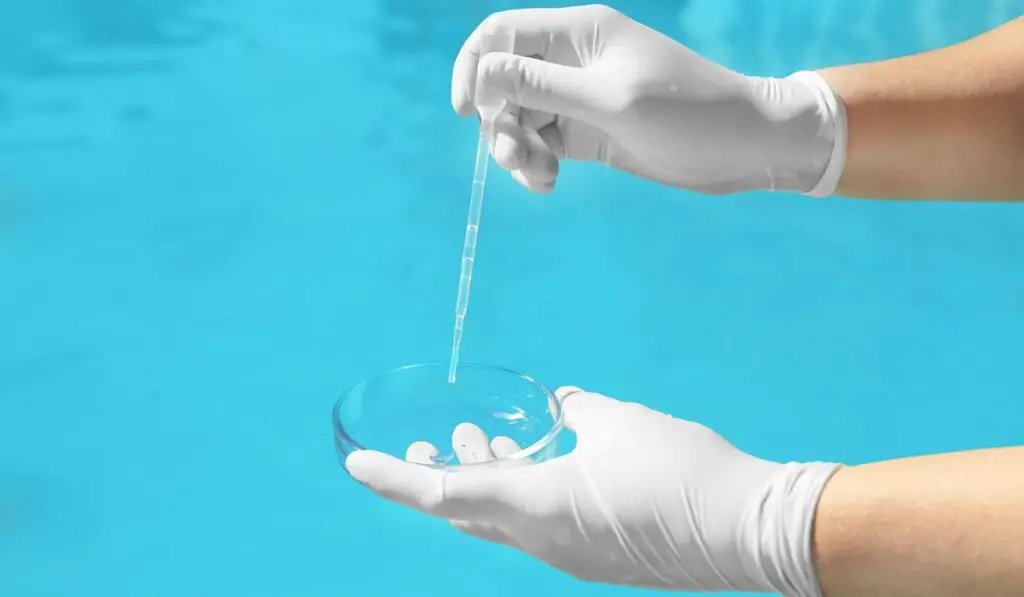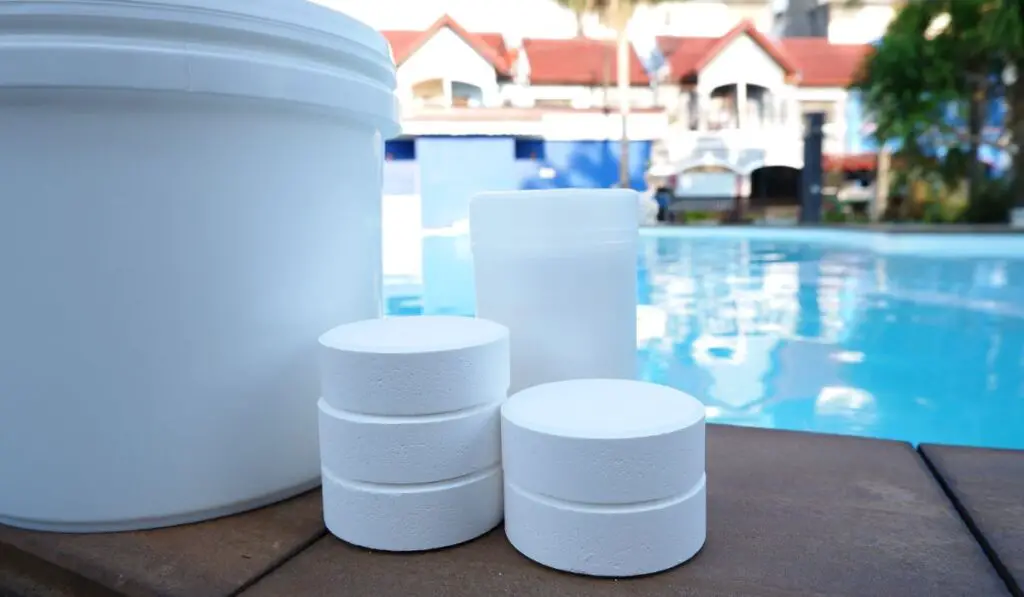If you have a swimming pool in your backyard, then you probably know how important it is to have certain chemicals added to your pool. These chemicals, such as cyanuric acid work to keep your pool in the best condition possible.
Cyanuric acid (CYA) is a chemical used to stabilize your pool water. When your levels fall outside of the recommended 30-50 ppm, you will find yourself constantly needing to add chlorine to your pool. Add CYA to your pool by purchasing CYA tablets, or adding chlorine which has been pre-stabilized.
Want to learn more about boosting cyanuric acid in your swimming pool? Let’s look at some of the best methods to do so to keep your pool in the best shape possible.
Understanding Cyanuric Acid

Cyanuric acid, often referred to as CYA, is used to condition and stabilize the water in your swimming pool. This chemical is an important part of the maintenance of your pool since it also protects the chlorine from dissipating too quickly.
In most cases, the chlorine in a swimming pool is susceptible to the sun’s UV light and can cause it to be used up sooner than you would normally like. The result of this is that you will need to add chlorine to the pool more often.
CYA acts as a barrier to keep the swimming pool’s chlorine level stable to allow it to work more effectively. When the CYA levels get too low, you will find that you have to add more and more chlorine to keep the water normalized.
Most swimming pool experts recommend that your CYA levels be between 30 and 50 ppm, or parts per million. It is also important to keep in mind that if you have a saltwater pool, your CYA levels should be slightly higher than this.
Another important factor to consider is that cyanuric acid is only needed if your pool is located outdoors. If you have an indoor pool, you will not have to worry about adding or maintaining the CYA levels since chlorine is not exposed to UV rays from the sun.
Signs of Low Cyanuric Acid Levels
When it comes to detecting low levels of cyanuric acid in your swimming pool, it is important to keep in mind that this is something that should be checked regularly. This can typically be done by using liquid test kits or even test strips that can be purchased at your local pool supply store.
One of the first signs that your CYA levels may be low is when you begin to notice that you are having to add in more chlorine than usual. This is because when the cyanuric acid levels are low, the chlorine in the water will begin to dissipate.
This is why it is highly encouraged that you keep a check on not only the ph levels in your swimming pool but other levels as well. Checking to ensure that the CYA levels are maintained at the recommended levels is vital to stabilizing your swimming pool water.
While low levels of cyanuric acid alone do not typically pose a risk to the swimming pool or to swimmers, there are other factors to consider. Since when CYA levels are low the chlorine is not as protected, you may be risking the chance of bacteria entering the water.
Reasons for Low Cyanuric Acid Levels
Like other chemicals that are required to be added to your swimming pool, there are many reasons for low levels of CYA. Many of these reasons are due to natural causes which is why keeping a check on the levels is vital.
One of the factors that could cause low levels of cyanuric acid is the type of chlorine you are using in your pool. Since you can purchase various types of chlorine, if you choose to use unstabilized tablets, you are going to have low levels of CYA.
Stabilized chlorine tablets have the added benefit of including cyanuric acid so that you will not have to worry about purchasing it separately. However, you may still get low levels of CYA for other reasons, meaning you may still need to purchase it.
Other reasons you may need to keep in mind that could cause your CYA levels to be low are caused by naturally occurring factors. If you live in an area where it rains often, or at all, you may find that the CYA levels in your pool are lower than normal.
Another cause of low cyanuric acid levels is due to the following:
- Splashing water out of the pool
- Evaporation
- A leak in the pool
Finding the cause can be challenging, however, it is vital to ensure that you put an action plan in place to prevent it from happening. The key is to investigate all possible reasons before deciding on the ultimate solution.
Methods for Raising Cyanuric Acid Levels
When it comes to the methods that can be used to raise cyanuric acid levels, there are two that can be used. Both of these methods work to raise the levels when you discover that your pool is low on CYA.
One of the first things that you will need to do before you decide to add CYA to your pool is to test the overall chemical levels of the water. This can be done with a liquid test kit (on Amazon) or test strips (on Amazon) that can be purchased anywhere you purchase pool supplies.
Use Stabilized Chlorine
The first method you can use to raise the cyanuric acid levels in your swimming pool is to ensure that you are using stabilized chlorine. This method is the easiest way to make sure that your swimming pool is protected from low levels of chlorine.
To use this method, all you need to do is make sure you are purchasing stabilized chlorine whether you use liquid, granular, or even tablets. This type of chlorine has cyanuric acid as one of the components in the mix so you will not need to use another method.
Use Pure Cyanuric Acid by Adding Pool Stabilizer or Conditioner
Whether you use stabilized chlorine tablets or not, you may want to consider additionally using a pool stabilizer or conditioner for your swimming pool. This will typically ensure that your pool’s cyanuric acid does not get low enough to deplete the chlorine altogether.
Know that by adding only 3 ounces of cyanuric acid you will be able to raise a pool that has a volume of 10,000 gallons of water by about 10 ppm. Since the recommended amount is only between 30 and 50 ppm, you need to be careful to not add too much if you choose to add pure CYA.
The advantage of using this method to keep the CYA levels in line with recommended amounts is that you can be sure that you are adding in exactly what you need. However, the biggest disadvantage of using this method is the concern that you can end up adding too much very easily.
To add cyanuric acid to your pool, you will need to use a 5-gallon bucket filled with water from your swimming pool. Once you have this prepared, you will then need to add the exact amount of CYA recommended for you based on the bottle instructions.
Once you have the bucket prepared, it is time to add the contents to your swimming pool as carefully as possible. Instead of adding it directly into your pool, you should pour the liquid into your pool skimmer while allowing your pump to move the acid around for a few hours.
Precautions and Safety Measures

As with working with any type of chemical for your swimming pool, you will need to take certain precautions and safety measures. Doing so will help to ensure that you are as safe as possible while using dangerous chemicals.
One of the first precautions you will need to take while using cyanuric acid in your pool is to make sure you have read the manufacturer’s instructions for handling the product. This may mean that you will need to wear protective gear such as goggles and gloves.
In addition to protective gear, you should also make sure that you are using the recommended safety measures by only adding the CYA to your pool water in a 5-gallon bucket. This will prevent the acid from splashing out of the bucket when doing it any other way.
Another precaution you will need to take when adding cyanuric acid is to be sure you are not adding too much. This is because too much CYA can cause certain damage to the lining and other components of your swimming pool.
Maintaining Cyanuric Acid Levels

After you have fixed the issue of having low cyanuric acid levels in your swimming pool, it is important to ensure that you are testing the levels regularly. Doing so will help you keep the chlorine in your pool from dissipating unexpectedly.
Here are a few tips to keep in mind when maintaining your CYA levels:
- Check your levels regularly
- Use stabilized chlorine tablets
- Add pool conditioner or stabilizer when levels are low
While you may only have to add a pool conditioner or stabilizer once or twice a year, you must keep a check on it regularly.
Troubleshooting Low or High Cyanuric Acid Levels
When it comes to troubleshooting the cyanuric acid levels in your swimming pool, you will need to be familiar with how to diagnose the problem. Whether your cyanuric acid levels are too low or too high, you will need to know the signs to look for.
As you are adjusting the levels of CYA in your swimming pool, it is important to ensure that you are avoiding the common mistakes that can be made. The most important of these mistakes is how much acid you need to add.
If you find that the levels are too low, you will need to add in a pool conditioner or stabilizer according to the manufacturer’s recommendation. When the levels are too high, it is important to note that this is much more difficult to change.
If you discover that your level of CYA is too high, then you will need to drain some of the water off the top of your swimming pool. While you do not need to drain all the water, you will need to drain enough to address the problem.
Conclusion
The bottom line with it comes to boosting cyanuric acid levels in your swimming pool is to always ensure that you are following the manufacturer’s recommendations.
The best way to make sure your levels are accurate is to test them regularly. Using stabilized chlorine can help ensure that you have just the right amount of CYA in your pool to keep it in the best condition possible.
